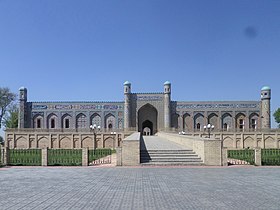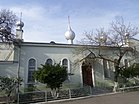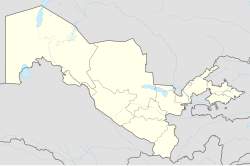Kokand
Qo‘qon / Қўқон Коканд | |
|---|---|
| Coordinates: 40°31′43″N 70°56′33″E / 40.52861°N 70.94250°E | |
| Country | |
| Region | Fergana Region |
| Government | |
| • Hokim | Ma'rufjon Usmonov |
| Area | |
• Total | 40 km2 (20 sq mi) |
| Elevation | 409 m (1,342 ft) |
| Population (2022)[1] | |
• Total | 259,700 |
| • Density | 6,500/km2 (17,000/sq mi) |
| Time zone | +5 |
| Postal code | 150700 |
| Website | qoqon |
Kokand (/ˈkoʊkænd/ KOH-kand)[a] is a city in Fergana Region in eastern Uzbekistan, at the southwestern edge of the Fergana Valley. Administratively, Kokand is a district-level city, that includes the urban-type settlement Muqimiy.[2] The population of Kokand as of 2022[update] was approximately 259,700.[1] The city lies 228 km (142 mi) southeast of Tashkent, 115 km (71 mi) west of Andijan, and 88 km (55 mi) west of Fergana. It is nicknamed "City of Winds". In 1877 when the first ethnographic works were done under the new imperial Russian administration, Khoqand/Kokand was reported and visually depicted on their maps as Tajik inhabited oasis (C.E de Ujfalvy (“Carte Ethnographique du Ferghanah, 1877”). The city and the entire eastern 3/4 of the Fergana Valley were included in Uzbekistan in the 1920s and Stalin's dictates of political borders.
Kokand is at the crossroads of the two main ancient trade routes into the Fergana Valley, one leading northwest over the mountains to Tashkent, and the other west through Khujand. As a result, Kokand is the main transportation junction in the Fergana Valley.
- ^ a b "Hududlar bo'yicha shahar va qishloq aholisi soni" [Urban and rural population by district] (PDF) (in Uzbek). Fergana regional department of statistics.
- ^ "Classification system of territorial units of the Republic of Uzbekistan" (in Uzbek and Russian). The State Committee of the Republic of Uzbekistan on statistics. July 2020.
Cite error: There are <ref group=lower-alpha> tags or {{efn}} templates on this page, but the references will not show without a {{reflist|group=lower-alpha}} template or {{notelist}} template (see the help page).





